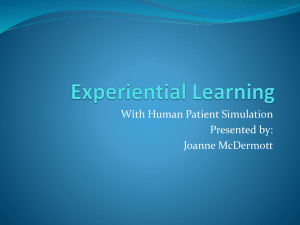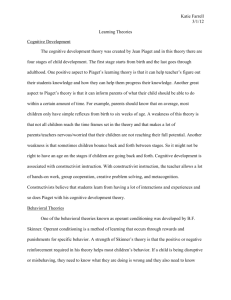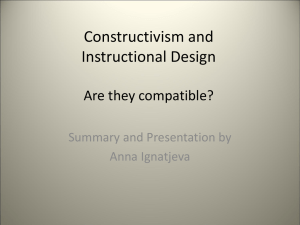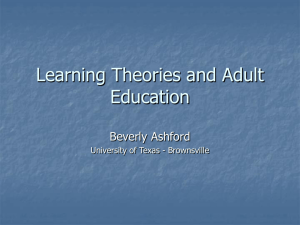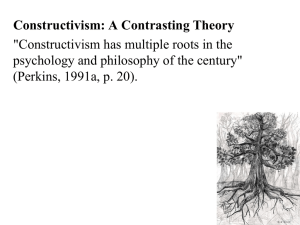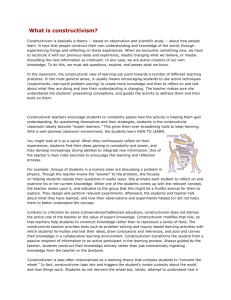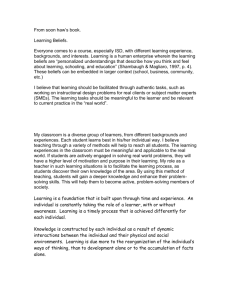Driscoll Chap 11 Constructivism
advertisement
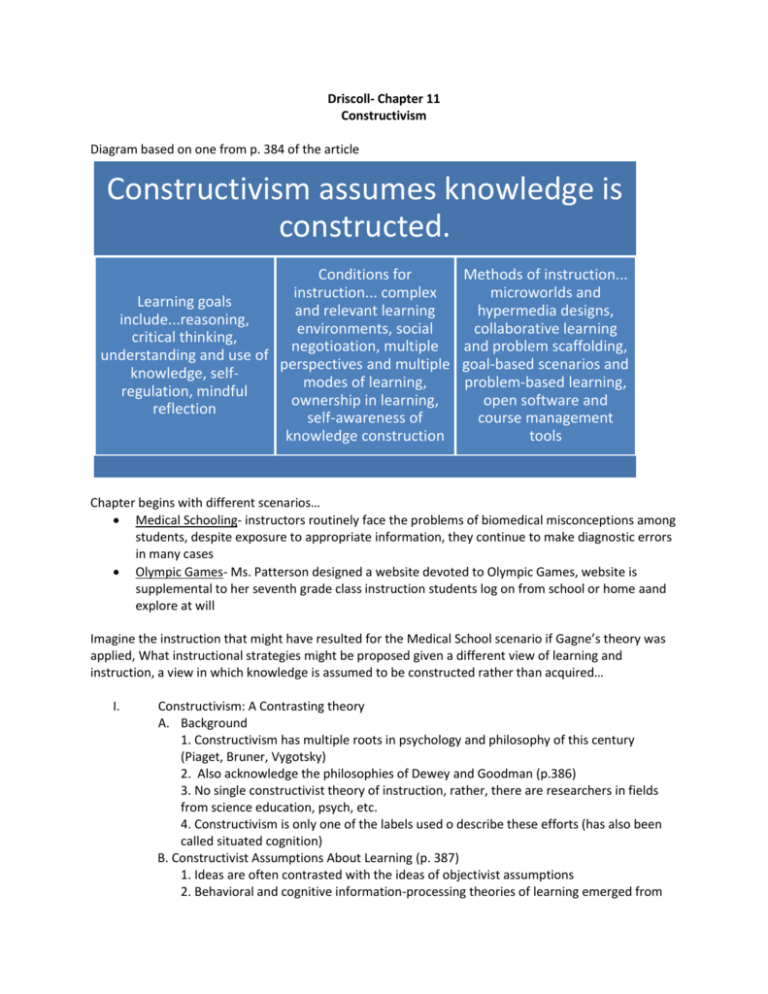
Driscoll- Chapter 11 Constructivism Diagram based on one from p. 384 of the article Constructivism assumes knowledge is constructed. Conditions for instruction... complex Learning goals and relevant learning include...reasoning, environments, social critical thinking, negotioation, multiple understanding and use of perspectives and multiple knowledge, selfmodes of learning, regulation, mindful ownership in learning, reflection self-awareness of knowledge construction Methods of instruction... microworlds and hypermedia designs, collaborative learning and problem scaffolding, goal-based scenarios and problem-based learning, open software and course management tools Chapter begins with different scenarios… Medical Schooling- instructors routinely face the problems of biomedical misconceptions among students, despite exposure to appropriate information, they continue to make diagnostic errors in many cases Olympic Games- Ms. Patterson designed a website devoted to Olympic Games, website is supplemental to her seventh grade class instruction students log on from school or home aand explore at will Imagine the instruction that might have resulted for the Medical School scenario if Gagne’s theory was applied, What instructional strategies might be proposed given a different view of learning and instruction, a view in which knowledge is assumed to be constructed rather than acquired… I. Constructivism: A Contrasting theory A. Background 1. Constructivism has multiple roots in psychology and philosophy of this century (Piaget, Bruner, Vygotsky) 2. Also acknowledge the philosophies of Dewey and Goodman (p.386) 3. No single constructivist theory of instruction, rather, there are researchers in fields from science education, psych, etc. 4. Constructivism is only one of the labels used o describe these efforts (has also been called situated cognition) B. Constructivist Assumptions About Learning (p. 387) 1. Ideas are often contrasted with the ideas of objectivist assumptions 2. Behavioral and cognitive information-processing theories of learning emerged from the objectivist tradition- behaviorists define desired learning goals independent of any learner, information processing theorists put mind back into the learning equation, assume that knowledge is out there to be transferred to the learner (true of behaviorists and objectivists) 3. Constructivists, on the other hand, rests on the theory that knowledge is constructed by learners as they attempt to make sense of their experiences, learners are not empty vessels to be filled, but rather, active organisms seeking meaning 4. This process of acquiring and constantly rebuilding knowledge has been described as many different things… development and revision of mental models, schema accommodation (Piaget), knowledge restructuring (p. 388) 5. Knowledge constructions do not necessarily bear any correspondence to external reality… children believing the earth is flat and that the sun moves across it’s sky, according to constructivist theory, this supports what children see in their environment surrounding them… we know this to be false 6. Most constructivists will argue not all constructions of knowledge are viable C. Constructivist Models of Memory 1. Constructivists have not been clear about what epistemological beliefs they have about memory 2. The books talks about Eco’s rhizome metaphor (p. 388) which I really don’t understand that well- a rhizome is, “a tangle of tubers with no apparent beginning or end”, it constantly changes shape, every point in it appears to be connected to another, unlimited potential for knowledge construction because it has no fixed points.. author compares it to a plate of spaghetti or a jar of marbles, which can be shaken and rearranged again to make a new design of marbles 3. The rhizome model alerts us to the possibility of different meaning, different truth, different worlds ************** I don’t understand this. Check p. 388-389 if necessary. I think they might be trying to say Constructivists don’t organize memory as systematically as others do, no NODES, or systems or inner-connections, memory can create new connections with different material depending on how we need to use it. That is my interpretation of this cripe. II. Constructivist Learning Goals A. Goals 1. Unlike objectivist approach that focuses on what the learner must know, the constructivist approach emphasizes learning in context 2. Can only be done in the context of meaningful activity (p. 390) 3. Knowledge must develop and continue to change with the knowledge of the learner 4. Learning is continuous, life-long process 5. Knowledge develops in context and is central to the notions of situated learning 6. Thinking activities can be defined as writing persuasive essays, engaging in informal reasoning, explaining how data relates to theories in scientific investigations, formulating and solving moderately complex problems that require mathematical reasoning 7. “Knowledge does not come into its own until the learner can deploy it with understanding” 8. Constructivists also interested in having students identify and pursue their own educational goals 9. Dick (1991) raised a concern about the lack of attention paid by constructivist to the entry behaviors of students- not all are capable to pursue an independent project 10. Perkins (1991) acknowledged this saying learners must “play more of the task management role than in convention instruction” 11. It is job of instructor to hold students in their zone of proximal development by providing just enough guidance, but not too much 12. Prerequisite skills and entry learning goals are not ignored by constructivists, they just attend more to higher-order goals B. Constructivist Conditions for Learning 1. Goals of constructivist instruction: problem solving, reasoning, critical thinking active and reflective use of knowledge 2. Variety of recs to bring about these goals 3. Learning conditions largely emphasize the process of learning 4. Conditions suggested by theorists for constructivist learning to occur (p. 393-401… a more detailed explanation of each appears on the pages listed after the condition below) a. Embed learning in complex, realistic, relevant environments (394) b. Provide for social negotiation as an integral part of learning (396) c. Support multiple perspective and the use of multiple modes of representation (398) d. Encourage ownership in learning (399) e. Nurture self-awareness of the knowledge construction process (401) C. Constructivist Methods of Instruction Table taken from p. 402 in the book Table 11.1 A Summary of Goals, Conditions of Learning, and Instructional Methods Consistent with Constructivism Instructional Goal Reasoning Critical thinking Retention Cognitive flexibility Conditions of Learning Complex, realistic and relevant environments that incorporate authentic activity Methods of Instruction Microworlds, problem-based learning Social negotiation Collaborative learning, Bubble dialogue Hypermedia Self-regulation Multiple perspectives are multiple modes of learning Ownership in learning Mindful reflection, epistemic flexibility Self-awareness in knowledge construction Open-ended learning environments, collaborative learning, problem-based learning Bubble dialogue, role plays, debates, collaborative learning D. Other methods that have shown or are likely to be effective in implementing constructivist conditions for learning 1. Microworlds and hypermedia designs (p. 403)- small, but complete subsets of real environments that promote discovery and exploration, design influence by research on mental models, offer a point of entry that matches the learner’s cognitive ideas 2. Collaborative learning and problem scaffolding- some is computer supported collaborative learning (CSCL), technology can facilitate, augment and even redefine interactions among members of a work group (p. 404) 3. Goal-based scenarios/problem-based learning- present a clear and concrete goal to be achieved and provide a task environment where learners learn and practice target skills (designing a car, starting a business, eradicating a disease) 4. Software shells and course management tools- largely empty of content providing instead functions that can be readily adapted to the user’s intended application, “Bubble Dialogue”- students create conversations among comic strip characters, including thoughts that would not be said out loud, have opportunity to express personal (and sometimes naïve) views of the world, contemplate multiple perspectives E. Summary and Conclusions 1. Not a coincidence Constructivism is gaining popularity at the same time as momentum for user-friendly computer technologies is building 2. Computer offers many opportunities for using Constructivist strategies 3. Not entirely clear as to whether Constructivism is a theory or a philosophy 4. Not competing with other theories but providing them with an alternative set of values that deserve serious consideration (p. 406)




